Contribution[Part 3] Toward a Future of Human Security and Well-being (3 of 3)Japanese Manufacturing’s Little-known Lineage
Highlight
Looking back over past R&D-100 Awards is one way to get an overview of the history and evolving philosophies of innovation through monozukuri (manufacturing). Known as the Academy Awards of technological innovation, the annual R&D-100 Awards honor the top 100 high-tech products to be commercialized around the world during that year. By doing so, they provide an objective view of the innovation happening at that time.
R&D-100 Awards and Monozukuri
Known as the Academy Awards of technological innovation, the annual R&D-100 Awards are presented to the year’s top 100 new high-tech products. Starting out as the IR-100 Awards of Industrial Research magazine launched in 1959, the subsequent renaming of the magazine to Research and Development (R&D) magazine led to their current guise as the R&D-100 Awards.
The R&D-100 Awards recognize industry, academia, and government-supported research across a wide range of fields, including advanced test equipment, innovative materials, breakthroughs in chemistry, biomedical products, consumer, products, and high-energy physics.
Hitachi’s polarized Zeeman atomic absorption spectrophotometer described in Article 2 of Part 3 and its principle of operation were recognized at the awards in 1979. Oak Ridge National Laboratory of the USA also received an IR-100 award around the same time as Hitachi, having a few years earlier succeeded in performing measurements on individual atoms. People from Oak Ridge showed interest in our new technique based on the principles of quantum physics and invited us to visit their laboratory. Oak Ridge was well-known for its work on isotope separation and earlier played a central role in the Manhattan Project.
My admission to the laboratory campus was preceded by a rigorous security check by the Ministry of Foreign Affairs, through the request of the U.S. government, a few months prior. Being subject to the uncertainty principle, single-atom measurement is a field where obtaining definitive proof is very difficult. Having received an award for such foundational research, I saw it as being the very essence of monozukuri. If innovations are to go on to become part of the fabric of society, it is of utmost importance that their foundations be firmly established. Honing your thinking through a process of experiment and conjecture is also of the essence.
At Oak Ridge National Laboratory, we discussed how we arrived at this idea, comparing notes and academic papers as we went and building a deeper trust and affinity. (The person I was dealing with at that time was Dr. G.S. Hurst.) What I came to realize during that time was that the essence of monozukuri lies in innovation that is led by sensibility. The principle of operation of the apparatus for single-atom analysis that gained the world’s attention is actually very simple. It is an extension of the principle behand a Geiger-Müller tube (or more correctly a proportional counter). Oak Ridge National Laboratory was known for housing some of the world’s largest isotope separation equipment (very large mass spectrometers) and equipment for concentrating uranium-235 (the isotope used to achieve nuclear fission chain reactions) utilizing a large number of centrifuges.
Innovation Led by Sensibility is the Essence of Monozukuri
While a series of new models of Hitachi’s polarized Zeeman atomic absorption spectrophotometer have been released to the world over the past half-century, the mechanism at the heart of the instrument that generates its magnetic field remains largely unchanged. Meanwhile, these new models have not been deleted from the catalog over this time. Rather than producing a steady stream of new products on a timescale of “dog years*1,” it sometimes seems to me that the real mission of monozukuri is to produce something that will unassumingly last for half a century.
Aircraft have also remained at the forefront of technology and represent another example of such a field. The workhorses of aviation have long lifespans, with aircraft designed and built half a century ago still in active service.
The Piper Cub series of aircraft made by Piper Aircraft, Inc. provides a classic example, dating back to the original Taylor E-2 Cub of 1929. Although the series has since split into several different model ranges with different engines and so on, more than 20,000 of the aircraft have taken to the air since the great success of the Super J-3 Cub, which was first certified in 1937. While the Piper Cub is now approaching its centenary, this landmark aircraft remains very popular. The aircraft continue to fly and to be bought and sold, and there are still companies out there who can supply spare parts.
They are also similar in price to a polarized Zeeman atomic absorption spectrophotometer, and while the two products hail from different industries, both are exemplars of monozukuri.
- *1
- In which the contrast between dog years and human years is used to exemplify the rapid pace of change in technology and other aspects of life.
Aeronautical Research Institute and Made-in-Japan Aircraft
In my role as a fellow and board member of the Research Center for Advanced Science and Technology (RCAST) at the University of Tokyo, I am currently straining to come up with ideas for forging a new vision and establishing a research and development framework with the ongoing assistance of Masakazu Sugiyama and Ryohei Kanzaki, the current and former center directors, respectively. In particular, as I have emphasized in these articles, I have taken care to be led by the evidence, putting a high value on primary sources and what is happening on the ground. I have also been studying the history of the Tokyo Imperial University Aeronautical Research Institute, the original organization from which RCAST subsequently emerged. I believe this to be of great value in getting at the true essence of monozukuri. Unfortunately, as I will recount below, there are some aspects in which it is very difficult to ascertain in the present day what really happened in the past.
In 1920, the year in which the Aeronautical Research Institute was established, the transition from airships to aircraft was still in its early days, having begun with the Wright Brothers’ success at manned powered flight in 1903. At Tokyo Imperial University, the study of aeronautics was introduced at the Faculty of Engineering in 1920. The Aeronautical Research Institute, meanwhile, truly was an organization that sought to be at the forefront of science and technology. Always keeping a degree of distance from military research, they also succeeded in 1938 in setting world records that were recognized by the Fédération Aéronautique Internationale (FAI). Indeed, it is said that, to this day, these remain the only two certified world records ever to have been set in the history of aircraft associated with Japanese aerospace. The more you investigate how the true leading edge of global progress came to be located in Japan, the more you will uncover examples that relate to the essence of research and development.
Although I received extensive help from experts in aviation history, as is already known to some extent, important documents were burned by the army in the immediate aftermath of Japan’s defeat in WWII or disposed of by the subsequent General Headquarters (GHQ) of the occupation authorities. Large numbers of aircraft were also destroyed, being buried by bulldozer or pushed overboard at sea, while those important documents and high-performance aircraft that did remain were confiscated. The result is that there is very little reliable material still in existence. It has also become clear that aspects of military aircraft have been exaggerated by the sub-culture and even aviation experts have fallen victim to a degree of misunderstanding.
Meanwhile, aircraft-related research was strictly prohibited by the GHQ for six years after the end of the war. What then became of the lineage of Japanese monozukuri during these missing years? To earn a living, the aviation engineers and scientists who had been at the forefront of science and technology at that time ended up scattered across a variety of other fields. One well-known example is the automotive industry and its post-war development. People also found new jobs in the shipbuilding and railway industries. That this underpinned Japan’s present-day monozukuri is something that is common knowledge.
Dating back to the YS-11, Japanese aircraft have not been very well known. Although Mitsubishi Heavy Industries made the news in recent years with its project for a new small passenger aircraft, it has unfortunately chosen not to proceed with this at the present time. Honda Motor has gone into the market for small aircraft for personal or corporate use and is striving to make headway through its innovative designs. I hope this will prove to be a success.
The flow of people back into the aircraft industry got started once the six-year research ban by GHQ was lifted. Prior to the war, the Kawanishi Aircraft Company put great effort into an aircraft that became a classic. This aircraft (a large flying boat known as the Kawanishi H8K) is still manufactured under the company’s new guise as ShinMaywa Industries in the form of the latest US-2, a large four-engine flying boat used for emergency relief. About five US-2s are currently in service as search and rescue aircraft operated by the Japan Maritime Self-Defense Force and the flying boats are also exported, albeit in small numbers. It offers remarkable performance and is unlike any other aircraft anywhere in the world. Although ShinMaywa Industries was once part of the Hitachi Group, it became a separate entity in 2004.
Figure 1—Historic Kawanishi H8K and Present-day US-2 Flying Boat
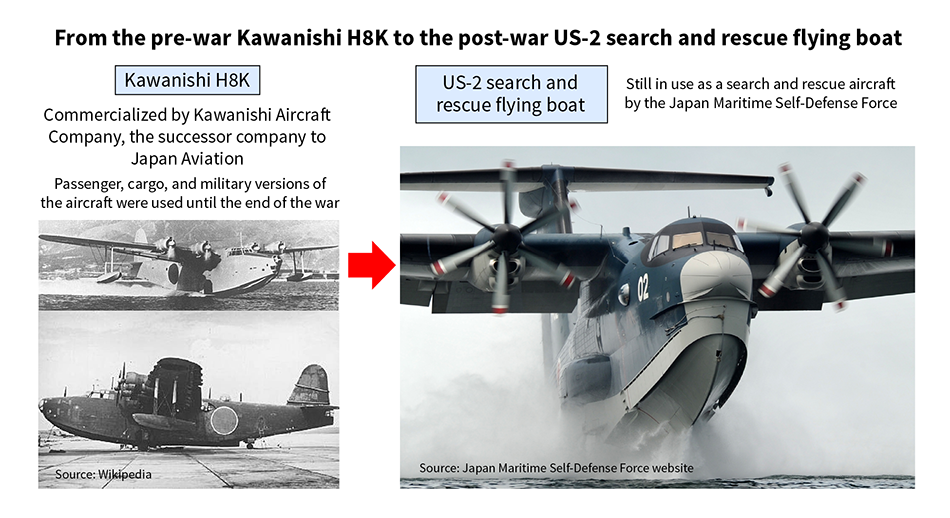 Established in 1923, Nippon Koku (Japan Aviation) developed numerous flying boats, moving on from single-engine to twin-, three-, and four-engine aircraft. With the dissolution of the company by government policy directive in 1928, the new Kawanishi Aircraft Company was established that same year (with Ryozo Kawanishi as company president and Shunichi Bando as managing director). From then until the end of the war, Kawanishi Aircraft developed and manufactured a variety of aircraft, flying boats among them.
Established in 1923, Nippon Koku (Japan Aviation) developed numerous flying boats, moving on from single-engine to twin-, three-, and four-engine aircraft. With the dissolution of the company by government policy directive in 1928, the new Kawanishi Aircraft Company was established that same year (with Ryozo Kawanishi as company president and Shunichi Bando as managing director). From then until the end of the war, Kawanishi Aircraft developed and manufactured a variety of aircraft, flying boats among them.
Figure 2—Features of US-2 Search and Rescue Flying Boat
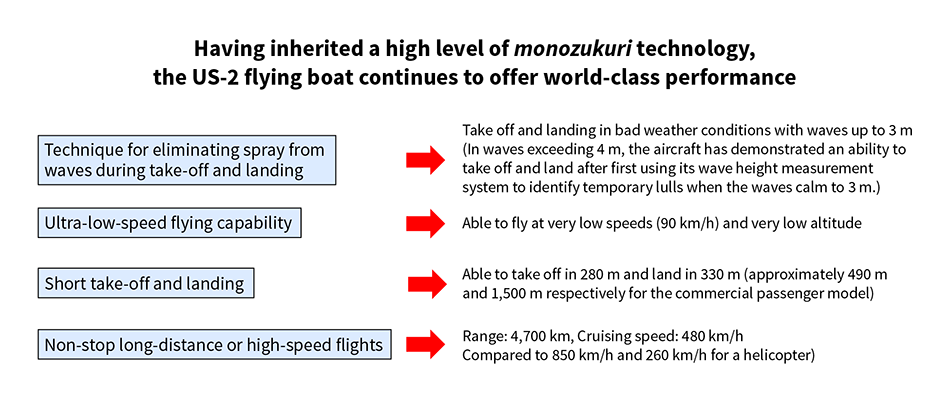 The current US-2 flying boat from ShinMaywa Industries boasts world-class performance.
The current US-2 flying boat from ShinMaywa Industries boasts world-class performance.
Despite being a large four-engine flying boat, a remarkable feature of the US-2 is its minimum speed of only 90 km/h (even slower than a car driving on a freeway) and its ability to glide (using a special anti-stall system). It can take off and land in poor sea conditions with waves up to 3 m. It is also possible for the flying boat to take off and land in rough 4-m seas by using its wave height measurement system to identify where the waves are only 3 m in height. It also features a range of 4,700 km and a cruising speed of 480 km/h.
Hitachi Kokuki and the Two Certified World Records Achieved by the Koken Aircraft
While little known in the world of aviation history, the existence of Hitachi Kokuki Kabushiki Kaisha (Hitachi Aircraft Company, hereafter Hitachi Kokuki) is recorded by the following words in the first edition of the chronology of Hitachi compiled by the company’s founder Namihei Odaira himself.
Appointed President of Hitachi Kokuki Kabushiki Kaisha in May 16, 1939 (age 66)
Merged with Tokyo Gas Electric Engineering Co., Ltd. on May 30
If you delve into the records of the Aeronautical Research Institute, you will learn about the manufacture of the Koken aircraft (Koken-ki) that astonished the world. It is an accomplishment that brings to mind the essence of monozukuri. The basic design utilized a large wind tunnel with a 3-m diameter that was constructed by the institute, with the airframe being divided into a number of parts with separate teams responsible for each. Cockpit development, for example, dealt not only with the aircraft’s controls, but also the research and development of a high-speed, ultra-precise gyroscope and an autopilot mechanism (including research into computers). Lacking any place of their own suitable for assembling the large airframe, the work was instead done at the Omori Plant of Tokyo Gas Electric Engineering (the predecessor of Tokyo Gas, one of the world’s largest city gas utilities) that was located close to Haneda Airport. As chance would have it, one of the people who worked at Tokyo Gas Electric Engineering had spent time in France and studied aircraft fabrication. The combustion group working on the project also had responsibility for improving the engines. Through these efforts, the Koken-ki was completed, an aircraft that only came to the attention of the public when it set two world records. This group would go on to form their own company, Hitachi Kokuki, with Namihei Odaira as its President.
Odaira’s chronology of Hitachi also records the following. I will write more about this later.
1944 (age 71): Viewed Tokyo Bay by aircraft (made at the Haneda factory)
Figure 3—Tokyo Imperial University Aeronautical Research Institute (Located at Komaba II Campus of the University of Tokyo), Predecessor of the University’s Research Center for Advanced Science and Technology
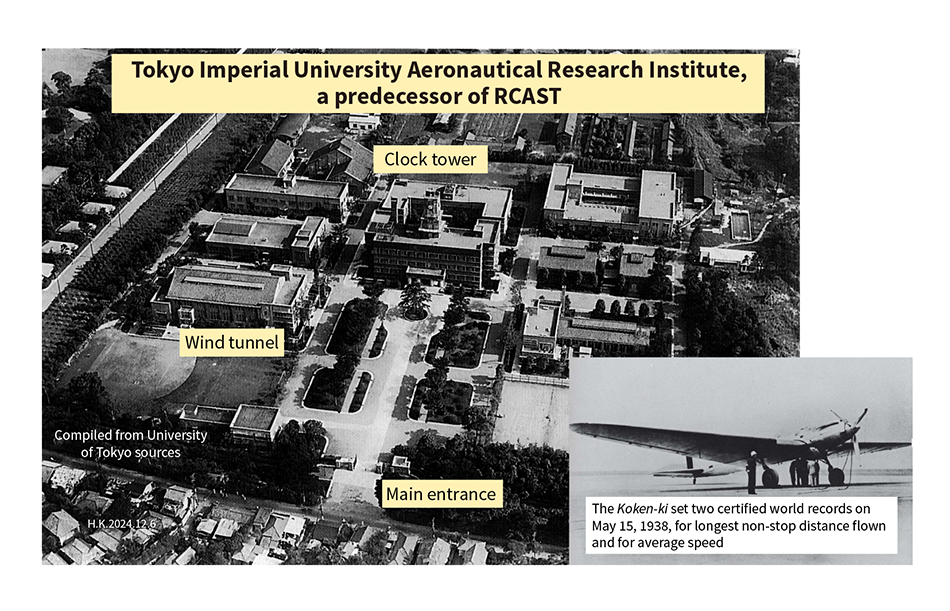 The Tokyo Imperial University Aeronautical Research Institute was a large research facility constructed at Komaba after the Great Kanto Earthquake. A predecessor of the University of Tokyo’s Research Center for Advanced Science and Technology (RCAST), it was located at what is now the university’s Komaba II Campus. Some of the major features of the institute remain fully intact to this day. These include the main entrance, clock tower building, wind tunnel facility, and machine shop. The main research teams at the institute worked together on developing the Koken-ki from the basic research phase, setting world records for longest non-stop distance flown and for average speed that were certified by the Fédération Aéronautique Internationale (1938).
The Tokyo Imperial University Aeronautical Research Institute was a large research facility constructed at Komaba after the Great Kanto Earthquake. A predecessor of the University of Tokyo’s Research Center for Advanced Science and Technology (RCAST), it was located at what is now the university’s Komaba II Campus. Some of the major features of the institute remain fully intact to this day. These include the main entrance, clock tower building, wind tunnel facility, and machine shop. The main research teams at the institute worked together on developing the Koken-ki from the basic research phase, setting world records for longest non-stop distance flown and for average speed that were certified by the Fédération Aéronautique Internationale (1938).
Figure 4—Model of Koken-ki Developed by Tokyo Imperial University Aeronautical Research Institute and World Record Certificate from Fédération Aéronautique Internationale
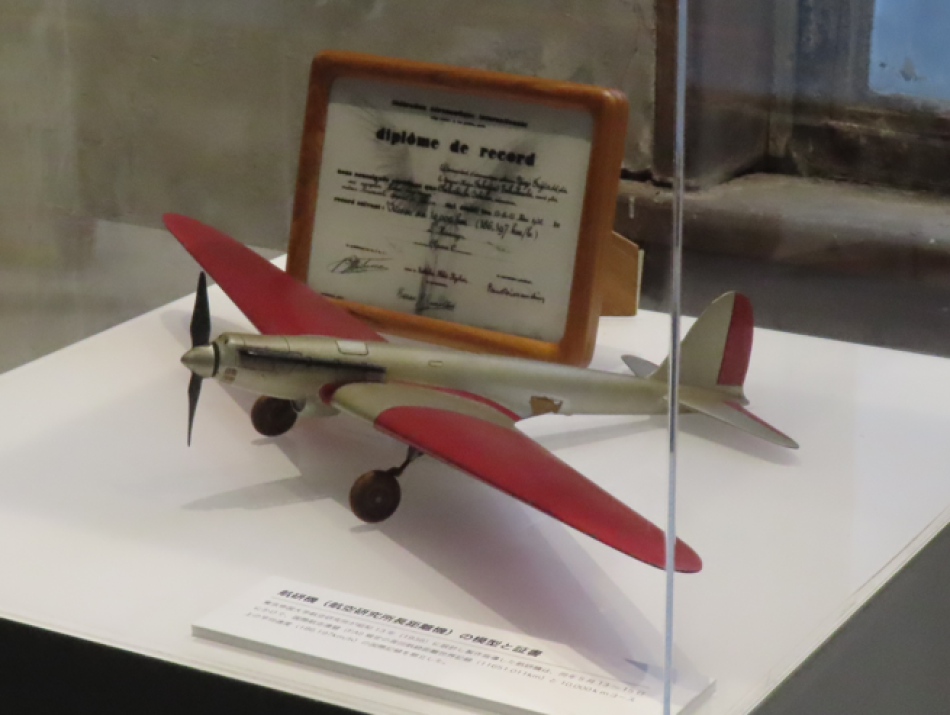 Known for its red wings, the records tell that the Koken-ki'’s use of red was to make it easier to find in the event of an emergency landing. The model remains on display in front of the 3-m wind tunnel that is preserved to this day at RCAST. The plaque at the rear is the actual world record certificate issued by the Fédération Aéronautique Internationale. The aircraft’s windshield was only fitted during take-off and landing, being stowed away manually during the flight. Assembly of the airframe took place at the Omori Plant of Tokyo Gas Electric Engineering (as it was then known).
Known for its red wings, the records tell that the Koken-ki'’s use of red was to make it easier to find in the event of an emergency landing. The model remains on display in front of the 3-m wind tunnel that is preserved to this day at RCAST. The plaque at the rear is the actual world record certificate issued by the Fédération Aéronautique Internationale. The aircraft’s windshield was only fitted during take-off and landing, being stowed away manually during the flight. Assembly of the airframe took place at the Omori Plant of Tokyo Gas Electric Engineering (as it was then known).
Figure 5—Koken-ki Overflying Aeronautical Research Institute After Setting its Two Certified World Records
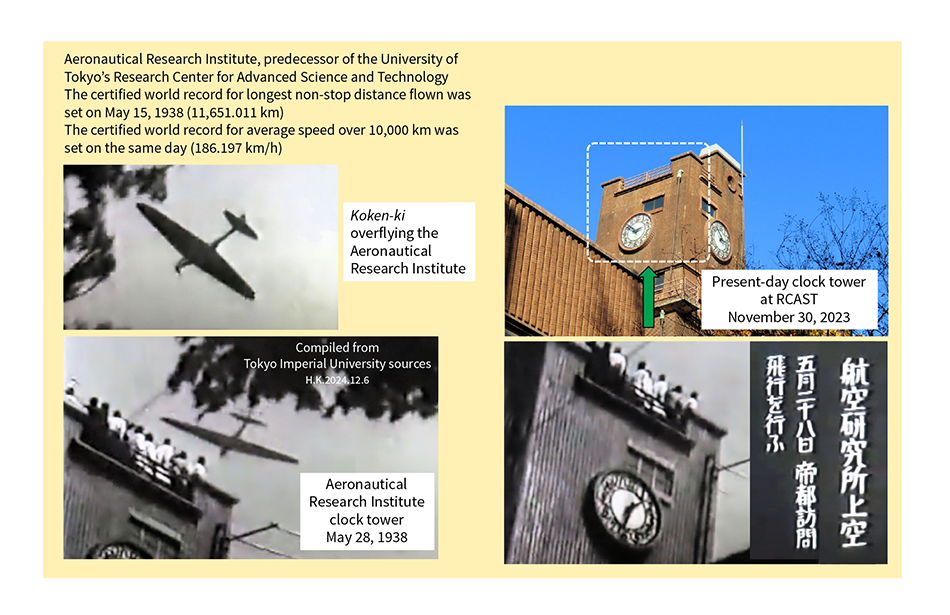 The world records certified by the Fédération Aéronautique Internationale were for non-stop distance traveled and for average speed in a flight of over 10,000 km. To this day, no other such certified aviation world records have been set in Japan. The people involved climbed the clock tower at the Aeronautical Research Institute where the design and testing of the Koken-ki took place and the aircraft flew a circuit around the institute in a flight to mark the accomplishment of the records. A similar flight took place around the Yasuda Auditorium clock tower at Hongo.
The world records certified by the Fédération Aéronautique Internationale were for non-stop distance traveled and for average speed in a flight of over 10,000 km. To this day, no other such certified aviation world records have been set in Japan. The people involved climbed the clock tower at the Aeronautical Research Institute where the design and testing of the Koken-ki took place and the aircraft flew a circuit around the institute in a flight to mark the accomplishment of the records. A similar flight took place around the Yasuda Auditorium clock tower at Hongo.
Although it is now the RCAST clock tower, the structure looks the same today. While all of the clock towers at the University of Tokyo are in the Gothic style with bilateral symmetry, the clock tower at RCAST is the only one with a clock that breaks this symmetry.
Hitachi Kokuki, Inheritor of Tokyo Imperial University’s Koken-ki
Looking at old photographs and papers from the Aeronautical Research Institute, you will see that the 3-m wind tunnel at the Komaba II Campus of the University of Tokyo is still there in its same location. The same is true of today’s Building 13 (the clock tower in front of the main entrance). What you will not find any trace of, however, are any buildings large enough to assemble the Koken-ki that set those world records. Investigate further, though, and you will come across Tokyo Gas Electric Engineering, a highly unusual monozukuri organization. Tokyo Gasu, the company that took over the gas supply operations of the Tokyo municipal government in 1885 (and later became Tokyo Gas Co., Ltd.), established an engineering division in 1910 that went on from the manufacture of gas fittings to produce steel products such as engines that utilized combustion technology. In time, it would also produce rolling stock. It happened that one of the skilled engineers working there had previously traveled overseas and studied aviation technology. The Aeronautical Research Institute took advantage of this. Rather than being under the direct control of the munitions industry, the facility worked with civilian engineering organizations. Tokyo Gas Electric Engineering and the Aeronautical Research Institute also worked together on an engine for aircraft able to fly long distances without landing, resolving to make major enhancements to an engine from the German company BMW. (Evidence suggests that the only thing left of the engine after these enhancements was its external shape.) Assembly of the full airframe took place at the Omori Plant of Tokyo Gas Electric Engineering. While I will not go into detail here about the Koken-ki that represents the best of monozukuri, many detailed photographs can be found in a Koken-ki photo album (published in 2003 by Seirinsha) that is now sadly out of print.
Reflecting on the fact that Hitachi, Ltd., the president of which was Namihei Odaira, was the company that absorbed and merged with Tokyo Gas Electric Engineering and subsequently relaunched it as Hitachi Kokuki, leaves me with a sense of the intriguing twists of history.
Figure 6—Namihei Odaira Aboard Biplane Trainer Made by Hitachi Kokuki
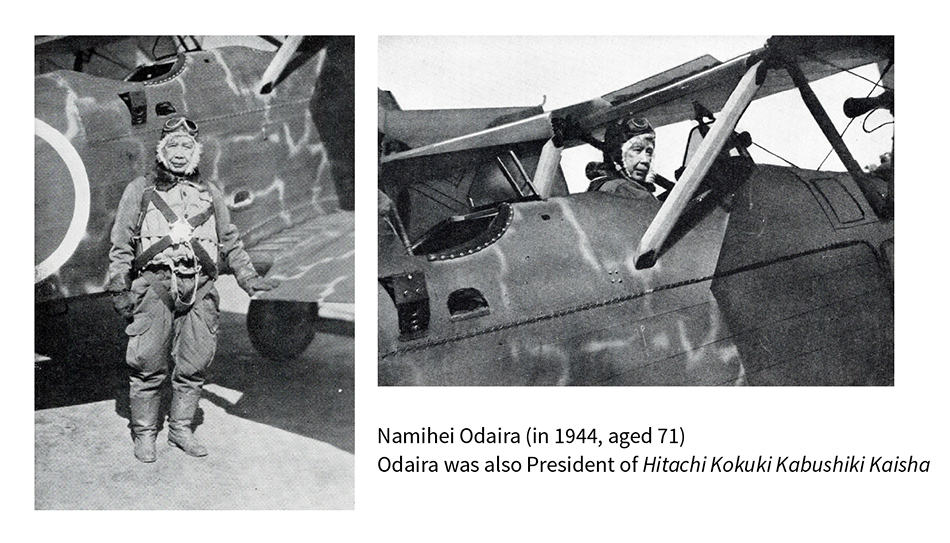 Not long after the Koken-ki set its world records, Namihei Odaira was appointed president of Hitachi Kokuki in 1939 and acquired Tokyo Gas Electric Engineering, the company that had built the aircraft. They subsequently developed the new biplane trainer shown here. This photograph shows Namihei Odaira in 1944 when he took a flight over Tokyo Bay in an aircraft built by the Haneda factory of Hitachi Kokuki*2.
Not long after the Koken-ki set its world records, Namihei Odaira was appointed president of Hitachi Kokuki in 1939 and acquired Tokyo Gas Electric Engineering, the company that had built the aircraft. They subsequently developed the new biplane trainer shown here. This photograph shows Namihei Odaira in 1944 when he took a flight over Tokyo Bay in an aircraft built by the Haneda factory of Hitachi Kokuki*2.
*2 Air trainers typically differ from aircraft with a simple design for beginner pilots to learn how to fly. For example, the T-4 jets used by the Blue Impulse aerobatic team of the Japan Air Self-Defense Force are high-performance aircraft that allow pilots to safely learn advanced flying techniques that take performance to its limits.
Twists and Turns in Development of Successor to the Koken-ki Inspired by Goal of Fostering Goodwill between Japan and America
As the end of the war approached, there was less freedom to engage in aircraft manufacturing and aeronautical research.
The successor to the Koken-ki, commonly known as the A-26, was designed by the Aeronautical Research Institute under contract to the Asahi Shimbun newspaper company. The original purpose was to foster goodwill between Japan and America by making a non-stop flight between Tokyo and New York to mark 2600 years since the Accession of the Emperor Jinmu (1940 by the Western calendar). This is how the aircraft got its name, with “A” being the first letter of Asahi and “26” representing the 2600th anniversary. The basic design produced by the Aeronautical Research Institute was for a beautiful twin-engine aircraft. The dream that initially inspired this endeavor was a flourishing of commercial flights between Japan and America.
Unfortunately, a rapid deterioration in Japan-US relations led to the project being put on hold. However, the development project was restarted at the direction of the military, which had taken note of the aircraft’s unparalleled range. The Tachikawa Aircraft Company*3 (located close to the Tachikawa airfield of the 5th Air Wing of the Japanese Army Air Force) was assigned to build the aircraft, with the design being a joint effort between Tachikawa Aircraft and the Aeronautical Research Institute. The official name of the aircraft was the Ki-77, designating it as an army prototype.
Following the attack on Pearl Harbor on December 7, 1941, the first and then the second of these aircraft were completed during 1942. The first undertook a flight of 16,435 km in 1944 with six people on board, taking 57 hours and 12 minutes to complete a triangular course from Xinjing to Harbin to Baicheng, a world record for a round-trip flight and a world speed record. Unfortunately, because this happened in wartime, the records were not recognized by the Fédération Aéronautique Internationale. The aircraft itself is no longer extant.
- *3
- The Ishikawajima Aircraft Manufacturing Company that relocated to Tachikawa in 1930 was renamed the Tachikawa Aircraft Company in 1936. By the end of the war, it had produced a total of 10,000 aircraft. Post-war, the company tried its hand at the development of electric vehicles but had its facility requisitioned by the US occupation. Engineers from the company who went out on their own established the Prince Motor Company, producing the Gloria* Skyline*, and other models before becoming part of Nissan in 1966. This monozukuri lineage can also be traced forward to the research and development of the rocket used in 1970 to launch the Ohsumi, Japan’s first space satellite, the bulk of which was done by the University of Tokyo Institute of Space and Aeronautical Science (1964), which, like the Aeronautical Research Institute, was another RCAST predecessor.
- *
- Gloria and Skyline are registered trademarks or trademarks of Nissan Motor Co,. Ltd.
Figure 7—A-26 (Successor Aircraft to the Koken-ki) Requisitioned and Removed by US Military
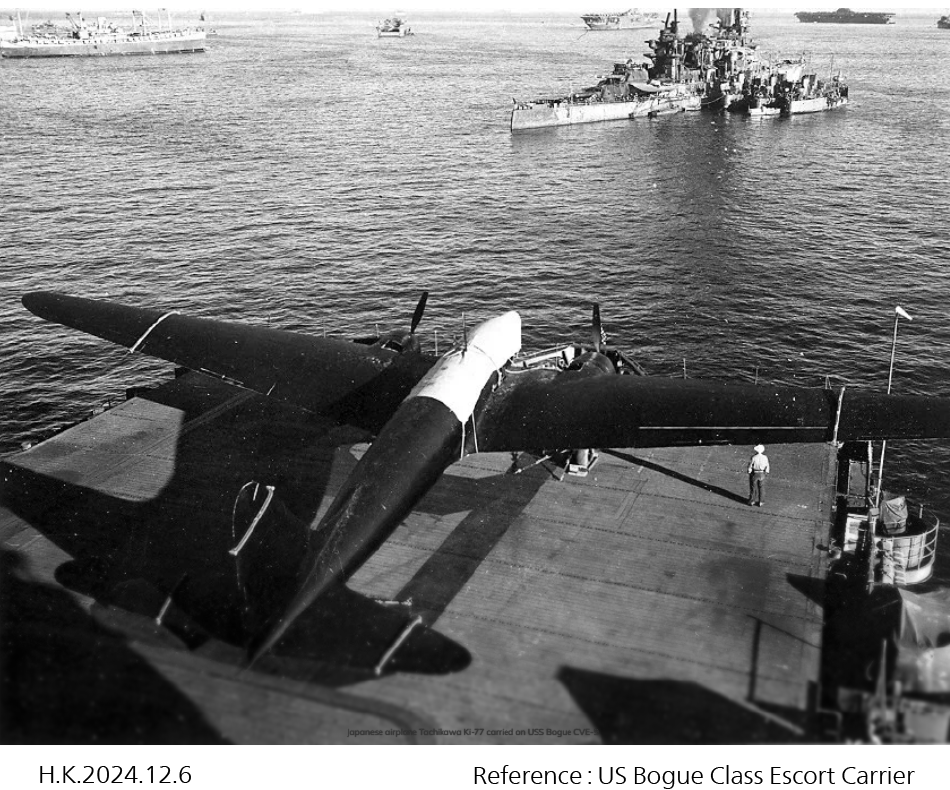 The photograph shows the A-26 aircraft developed by the Aeronautical Research Institute as a successor to the world-record-setting Koken-ki. (Not to be confused with the Douglas A-26 Invader made by McDonnell Douglas, the A-26 was built by the Tachikawa Aircraft Company and designated the Ki-77 long-distance prototype by the army). The aircraft was requisitioned by the US military and stowed on the bow of an aircraft carrier for study. Unfortunately, after this photograph was taken, it was abandoned in a storm during the voyage back to America.
The photograph shows the A-26 aircraft developed by the Aeronautical Research Institute as a successor to the world-record-setting Koken-ki. (Not to be confused with the Douglas A-26 Invader made by McDonnell Douglas, the A-26 was built by the Tachikawa Aircraft Company and designated the Ki-77 long-distance prototype by the army). The aircraft was requisitioned by the US military and stowed on the bow of an aircraft carrier for study. Unfortunately, after this photograph was taken, it was abandoned in a storm during the voyage back to America.
This photograph capturing the A-26 turned up in the public archives of the US Navy. The A-26 was a major advance over the Koken-ki and was intended to undertake a good-will flight non-stop from Tokyo to New York (with the outbreak of war, Japan-US relations rapidly deteriorated before this could happen).
Something else captured in the background of the photograph and identifiable by its profile is the battleship Nagato that was launched in 1920. It was the only warship that remained operational at the end of the war.
Monozukuri Masters Gathered at Hiratsuka in Shonan
Figure 8—The Odaira Brothers Gihei (Born 1871) and Namihei (Born 1873)
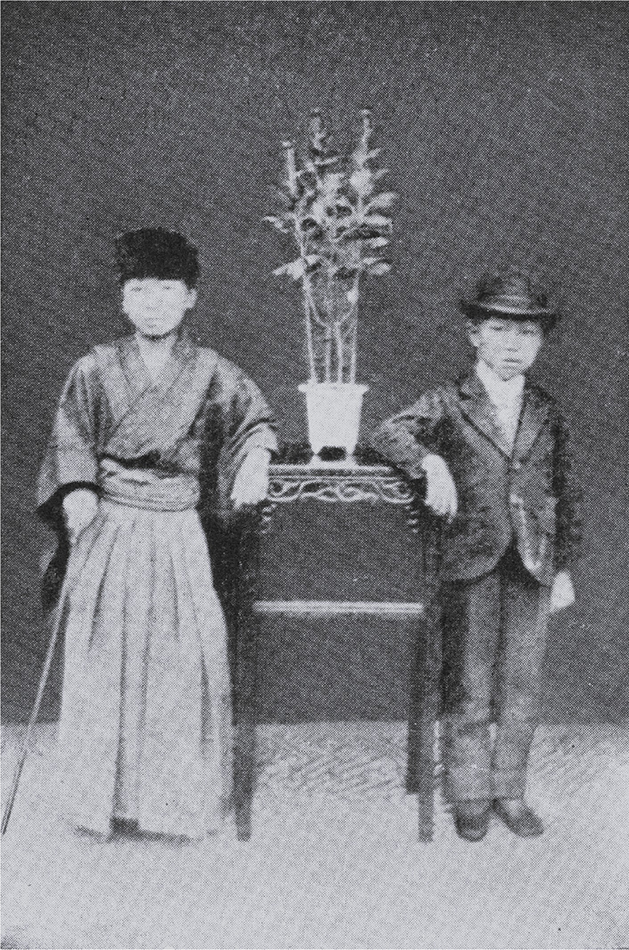 A chance meeting between a 12-year-old Namihei Odaira and an itinerant Gensai Murai (then 23 years old) took place in 1886, three years after this photograph was taken. Murai would subsequently join the Odaira household as tutor to the two boys. Although reputed to be reserved, Murai doted on Namihei Odaira like he was his decade-younger brother and the close relationship between them lasted until the former’s death in 1927 at age 64.
A chance meeting between a 12-year-old Namihei Odaira and an itinerant Gensai Murai (then 23 years old) took place in 1886, three years after this photograph was taken. Murai would subsequently join the Odaira household as tutor to the two boys. Although reputed to be reserved, Murai doted on Namihei Odaira like he was his decade-younger brother and the close relationship between them lasted until the former’s death in 1927 at age 64.
Going by the historical facts, Hitachi founder Namihei Odaira was someone who put software ahead of hardware and it is highly likely that he foresaw how civilization would make great strides over the coming century.
I believe that this is something that Namihei Odaira took to heart from Gensai Murai (1864-1927), a person he respected from a young age. As I will describe below, Odaira’s first meeting with Murai happened at the impressionable age of just 12 years, with the companionship between the two men going on to last for half a century. While hardware was being solidly executed back at Hitachi City, Shonan appears to have been the place where, together with the sympathetic Naosaburo Takao, his thoughts turned to the Greater Hitachi Concept, including ideas of software.
Gensai Murai’s father Kiyoshi Murai (known also as Yuemon Murai, 1834-1894) was a great scholar of the Chinese classics and served the Yoshida Domain of Mikawa that was affiliated with the House of Tokugawa. Following defeat in the Boshin War, he relocated from Toyohashi to Tokyo where he lived in Ueno Okachimachi and entrusted his son Yutaka Murai (another name for Gensai, who in 1871 was aged nine) to the care of a Russian missionary, Ivan Dmitrovich Kasatkin (known as Nicholas of Japan, 1836-1912) to learn about foreign cultures. The missionary Nicholas’s subsequent return to Japan to build the Nikorai-do (Holy Resurrection Cathedral) happened some 20 years later. (I have provided more details about the career of Gensai Murai in Article 2 of Part 2 .) His father, Kiyoshi Murai, was recognized as a Confucian scholar by Eiichi Shibusawa (1840-1931) and hired as a tutor for his children. Proficient in a number of foreign languages, Gensai Murai traveled to the USA using prize money from an essay competition and funds raised by his father, Kiyoshi. He spent a year in America, staying with a family of Russian immigrants and learning much about the modern nation state. After returning to Japan in 1885 (age 22) he became something of a nomad [an experience that would later give rise to his Meiji-era best seller, Shokudoraku (Gourmet)].
In 1887 (age 24), he happened to catch the eye of Namihei Odaira’s father when passing through Tochigi, which led to him spending half a year living in the Odaira household as a tutor. He exposed the young and impressionable Odaira (age 14) to European and American culture and, from that time on until his death in 1927 at age 64, acted as a bulwark for the younger man’s core ideals and spirit. I don’t believe it is possible to properly understand what terms in public parlance like Hitachi Spirit and Daikokuya Kaidan (Daikokuya meeting) truly mean unless we take the correct lesson from this curious historical fact.
In the chronology, the first edition of which Namihei Odaira wrote himself in his old age, the April 12 entry for 1894 (when Odaira was 21) records that he “Decided to study electrical engineering after discussing it with Gensai Murai.” While major events were held in 2024 to mark the 150th anniversary of Odaira’s birth, as far as I am aware, the only place where Gensai Murai’s name appeared on one of the exhibition panels was the one that carried this line from the chronology. This suggests to me a need to investigate further into the early history of Hitachi, the company.
Reinterpretation of Hitachi Spirit Informed by Historic Facts
The memorial collection, Memories of Odaira-san (totaling 356 pages), was produced privately (and published in 1952) on the occasion of Namihei Odaira’s death in 1951 at age 78. On close reading, one can infer what were especially crucial ideas for Namihei Odaira, a person who believed in action before words, from the frank views of a large number of the people he dealt with and from the documents available for reference. It can also be seen in the context of historic facts.
Figure 9—Hitachi Company President Namihei Odaira and Vice President Naosaburo Takao
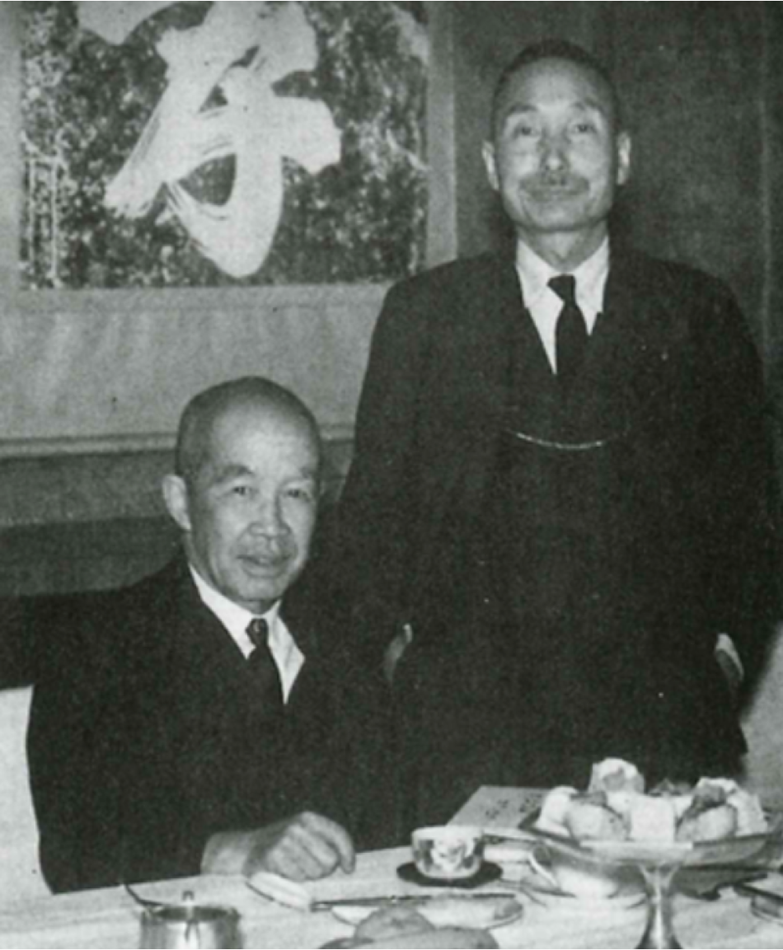 Photograph taken after lecture at Tokyo Hitachi Society (March 27, 1940)
Photograph taken after lecture at Tokyo Hitachi Society (March 27, 1940)
Considerable historic material testifies to Naosaburo Takao being someone who, quietly and behind the scenes, was devoted to the older Namihei Odaira. A Takao Fund was established at a memorial to Odaira held in 1994. Underpinned by funds provided by Takao and with the assistance of the Graduate School of Science and Engineering at Ibaraki University, the fund undertook new initiatives that included public education courses. Takao was someone who promoted regional education and put a lot of effort into the development of Hitachi City, including his role in setting up Taga Technical Specialists' College(1939), one of the institutions from which the College of Engineering at Ibaraki University was established in 1949. Following the death of Gensai Murai, Takao and Odaira each inherited a third share (approximately 16,500 m2) of the site of Murai’s home, a property that included a large orchard, vegetable garden, and farm. They each built a second home on the land. With a view out over the sea off Shonan and the sound of wind in the pines, it is recorded that they would talk, sometimes late into the night, about the Greater Hitachi Concept. In the present day, a monument erected by Naosaburo Takao stands in Gensai Park in Hiratsuka and reads, “Having inherited this 5,000-tsubo (approximately 16,500 m2) property from Gensai Murai in the seventh year of the Showa Era (1932), it was here that I built a second home among the pines and honed the Greater Hitachi Concept while listening to the sound of the wind in the trees. The house burned down during an air raid in July 1945 ... (1964 Nao).” (Nao being an abbreviation of “Naosaburo Takao”)
Naosaburo Takao also did a wonderful job of collating documentary material that showed Odaira from a different perspective (namely a record of a superior’s actions as viewed objectively by a subordinate). He kept an objective record of Odaira’s actions without commenting on the intentions. This humility offers proof of how well he understood Odaira.
Having become a lifetime companion of Namihei Odaira after Odaira invited him to work at Hitachi as an intern from the University of Tokyo, Naosaburo Takao (who later become Hitachi’s Vice President) recorded his respect and affection for his friend in the memorial collection. Similarly, Kumeo Baba (later a General Manager), who came to Hitachi a year after Naosaburo Takao, also provided a contribution entitled “About the Hitachi Spirit.”
In these words, Kumeo Baba also recounts that, because Namihei Odaira was an extreme example of someone who acted with few if any words and practiced secret charity, no written record remains. Kumeo Baba noted that, although he wanted to preserve for future generations what was valuable in Namihei Odaira‘s thinking that epitomized the Hitachi Spirit, this lack of a written record meant that his only option was to call on his own imagination. Indeed, in his “About the Hitachi Spirit” contribution to Memories of Odaira-san, Kumeo Baba wrote the following words.
“As someone who saw events in the whole, there were aspects of Odaira-san that were inscrutable, being terse of speech and not wasting words in his writing. As a result, these provided little insight into who he was.” “For the most part, he belonged to that class of men who acted without words and practiced secret charity, being very economical in how he carried himself.” “Odaira-san was never someone who wrote things down. He was well known for this and would not write anything despite all our urgings to do so. I cannot say that I didn’t find him to be very stubborn.”
Kumeo Baba had a deep knowledge of Mitogaku (a school of historical and Confucian studies). He also wrote, “It is a motto of Mitogaku that truth is the way of heaven, devotion to truth is the way of man. Odaira-san never deviated from the second of the paths in this saying, which comes from the Confucian Book of Rites.” “Uchikome tamashi shigoto no ue ni (inject spirit into your work) is the expression that Takao-san coined to express the true spirit of Odaira-san and it also carries a meaning of eliminating self-interest and making a correct effort.”
Kumeo Baba also wrote that, “Rather than imitating Odaira-san ... I adapted his approach and wove it into the Hitachi Spirit. In theory, although I still believe it was in no way a mistake, it also seems a little unrealistic. Odaira-san’s approach was that, although the idea of matching words with actions is correct in principle, it is also something that hardly anyone can put into practice, and that is why he lived a life of action rather than words. It is a case where trying to imitate it would not at all be a mistake, and not imitating would result in failure.” Namihei Odaira began learning about Confucianism from Gensai Murai at the age of 12. One can assume that Baba engaged in a serious study of Mitogaku, which follows in the Confucian tradition (being a Confucian way of thinking that swept the Mito Domain in a single generation), out of a realization that the hidden thoughts of Namihei Odaira must necessarily have been underpinned by this philosophy. (Baba had acquired fundamental knowledge of the topic from a young age.) The Hitachi Spirit widely visible around the Hitachi Group was an effort by Kumeo Baba to convey the thinking of Namihei Odaira to people at the company and to later generations. Certainly, it seems likely that the thinking of Gensai Murai’s father, the Confucian scholar Kiyoshi Murai, was passed down through the descendants of the children of Eiichi Shibusawa for whom he was hired as a tutor. In fact, Ken Shibusawa (the great-great-grandchild of Eiichi Shibusawa), a personal friend of mine, still regularly puts out a bulletin entitled Rongo to Soroban (Analects and Abacus).
However, what Gensai Murai (son of Kiyoshi Murai) working as a tutor was really all about was not primarily to do with Confucianism. Rather, he used it as a pedestal to contemplate the future of the world, ideas he would later publish as “A Prophecy for the 20th Century.” The person who, drawing on the predictions of Gensai Murai, would go on to extensively discuss the Greater Hitachi Concept with Namihei Odaira, looking ahead 100 years into the future, was Naosaburo Takao. This happened at Hiratsuka, with Mount Fuji in the background and a view out over the sea off Shonan. This, it seems to me, is why he would later provide us with his alternative account of Namihei Odaira, without writing directly about the Hitachi Spirit but with an unassuming enthusiasm that seeps out between the lines. What the Hitachi Spirit may really be about is putting in a steady and earnest effort day after day while still looking objectively ahead to the world a century from now.
For all the grounding Namihei Odaira had in Confucianism, he said and wrote little about the topic and it does not form a significant part of the Hitachi Spirit. This is clear from some of the main examples of his calligraphy that are still extant (see Figure 10).
Figure 10—Notable Calligraphy Left by Namihei Odaira
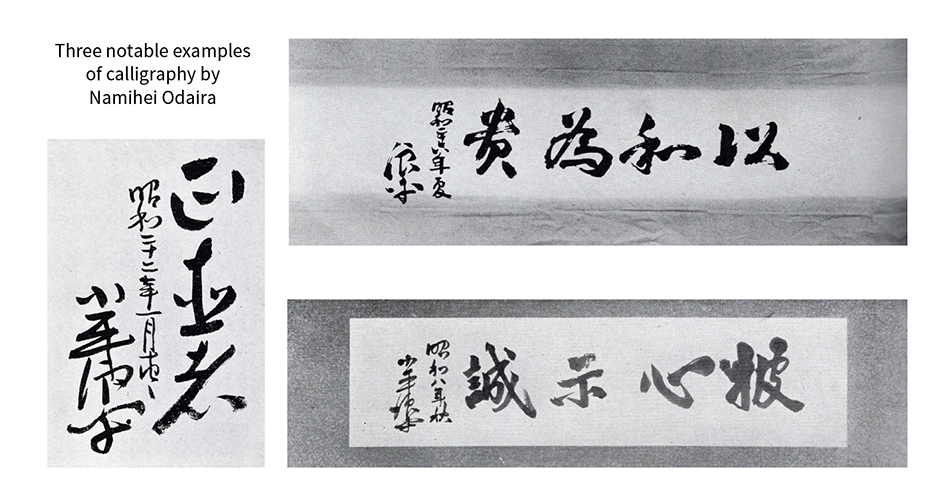 The calligraphy of Namihei Odaira is of a high aesthetic standard. As noted in the main text, however, very little of it remains in the world. The characters “以和為貴” (treasure harmony) on the top right date from the summer of 1951 and were dyed on hand towels distributed after his exclusion from public office ended on June 20. On October 5 of that year, he passed away. As I wrote in “Treasuring Harmony” in
Article 3 of Part 2
, this expression is the first article of The Seventeen-Article Constitution as recorded in “Nihon Shoki” (The Chronicles of Japan) by Prince Shotoku (famed for his virtuous character and his contributions to the state and ethical governance, his name can be interpreted as Prince of Supreme Virtue; he is known in current history text books as Prince Umayado). The 17th and last article of the constitution represents the foundations of democracy. While the Chinese Book of Rites and the Analects of Confucius contain similar words, they come with the provision “propriety is ...” and so the meaning is not the same as in Japanese thinking. The four characters in the calligraphy express something that is closer to philosophical thought than to Confucianism.
The calligraphy of Namihei Odaira is of a high aesthetic standard. As noted in the main text, however, very little of it remains in the world. The characters “以和為貴” (treasure harmony) on the top right date from the summer of 1951 and were dyed on hand towels distributed after his exclusion from public office ended on June 20. On October 5 of that year, he passed away. As I wrote in “Treasuring Harmony” in
Article 3 of Part 2
, this expression is the first article of The Seventeen-Article Constitution as recorded in “Nihon Shoki” (The Chronicles of Japan) by Prince Shotoku (famed for his virtuous character and his contributions to the state and ethical governance, his name can be interpreted as Prince of Supreme Virtue; he is known in current history text books as Prince Umayado). The 17th and last article of the constitution represents the foundations of democracy. While the Chinese Book of Rites and the Analects of Confucius contain similar words, they come with the provision “propriety is ...” and so the meaning is not the same as in Japanese thinking. The four characters in the calligraphy express something that is closer to philosophical thought than to Confucianism.
The characters on the left, “正直者” (honest person), were written during the New Year, the year of Odaira’s exclusion from public office (1947).
The characters on the bottom right, “披心示誠” (sincerity from the heart), were written in the Fall of 1933, a few months before Odaira’s sixtieth birthday and these too derive from a Japanese way of thinking.
Site at Hiratsuka in Shonan, Haloed by Mount Fuji and Overlooking the Pacific
Namihei Odaira’s lifetime mentor, Gensai Murai, had a special fondness for the area of Hiratsuka. It made an ideal spot for dreaming up visions of the future on a scale of a hundred years. In order to distance themselves somewhat from the Japanese military of the time, Shunichi Bando established the company Nippon Kokusai Koku Kogyo (Japan International Airline Industries), moving away from their previous facilities near the Inland Sea and Lake Biwa to set up a factory and research center at Hiratsuka.
I have, as yet, failed to come across any record of the two men speaking to one another at Hiratsuka. However, the first time I met Shunichi Bando, he showed a strong familiarity with Hitachi.
It would be highly unlikely for him to have not encountered the names Gensai Murai and Namihei Odaira when he went to Hiratsuka to scope out the location prior to choosing the 165,000-m2 site and constructing a factory and research center. The Koken-ki of the Aeronautical Research Institute appeared on postage stamps from that time and Bando’s new company made use of the wind tunnel at the Aeronautical Research Institute as part of the rigorous basic research they conducted, having decided to work on variable-pitch propellers. Tokyo Gas Electric Engineering made use of that same wind tunnel in manufacturing the Koken-ki, the aircraft that set the certified world records, and was subsequently relaunched as Hitachi Kokuki by Namihei Odaira with himself as Chairman. Shunichi Bando was closely involved with the prototype of the air trainer built at the Hitachi Haneda factory. Seeing the resolute figure of Namihei Odaira clad in his flight suit for a flight over Tokyo Bay in this trainer aircraft, I feel a sense of continuity that embodies the dream of civilian aviation (see Figure 6).
Figure 11—Namihei Odaira and his Wife at their Second Home where he Contemplated his Greater Hitachi Concept
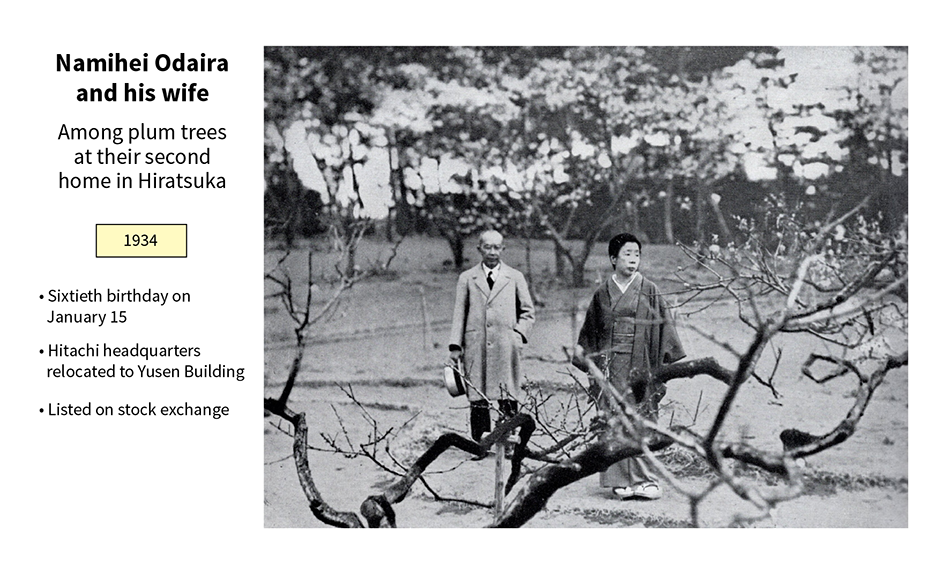 The following entries are recorded in Namihei Odaira’s chronology.
The following entries are recorded in Namihei Odaira’s chronology.
1932 (age 59)
Construction of second home at Hiratsuka completed.
1936 (age 63)
February 22
Acquired Osaka Iron Works
February 29
Appointed Chairman of Osaka Iron Works (Hitachi Zosen*4)
Hitachi, Ltd. first entered the naval and shipbuilding business and then the aviation business. While likely part of the Greater Hitachi Concept, details have not yet been confirmed.
*4 Osaka Iron Works was one of three large shipyards in Japan during the latter years of the Meiji Era. It was renamed Hitachi Zosen (Hitachi Shipbuilding, to express its focus on shipbuilding) in 1943, and was subsequently renamed again, as Kanadevia Corporation, in 2024.
In this article, I am endeavoring to draw on historical facts to get a glimpse of the Greater Hitachi Concept in terms of how it was envisaged by the company founder Namihei Odaira himself. The idea of producing goods domestically that prevailed when the company was first established was no more than a starting point and it seems that the person looking a century ahead to the age of information was Namihei Odaira.
Figure 12—Sun Rising over the Ocean at Hitachi and at Shonan Ohiso
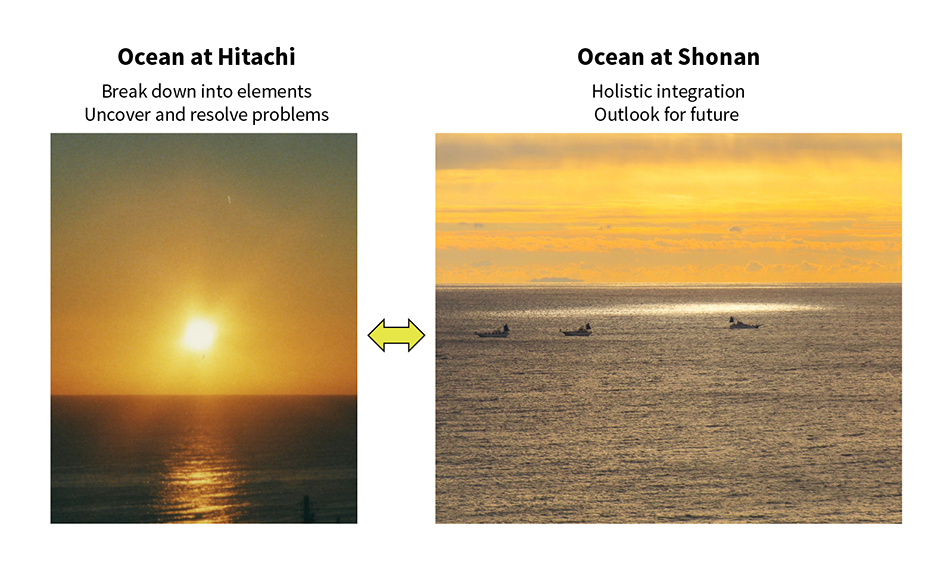 Whether viewed from Oarai, from the Natsumi shore, or from Omika lighthouse, the sun rising over the ocean at Hitachi (left) is a beautiful sight. It leaves a deep impression. From the early days of Hitachi to the present, it is not hard to imagine many monozukuri engineers being inspired to a variety of different thoughts while looking out at the rising sun.
Whether viewed from Oarai, from the Natsumi shore, or from Omika lighthouse, the sun rising over the ocean at Hitachi (left) is a beautiful sight. It leaves a deep impression. From the early days of Hitachi to the present, it is not hard to imagine many monozukuri engineers being inspired to a variety of different thoughts while looking out at the rising sun.
The sun rising from the sea at Shonan (right) has a different character. Whereas the sea at Hitachi is open ocean, the waters off Shonan Ohiso are sheltered, being enclosed by Sagami Bay. This is a place where many politicians and intellectuals have looked out at the Pacific Ocean with the heights of Mount Fuji in the background(Photos by HK).
In the year of his death, Namihei Odaira returned to Hitachi and made a gift to the people there of hand towels dyed with the expression “Harmony is to be valued,” Article 1 of the Seventeen-Article Constitution by Prince Shotoku. While this sentiment has its origins in Confucianism, you will find on further examination of its meaning that it was created in Japan and differs from the sequence of characters used in China. Article 17 in the background reads 夫事不可独断・必興衆宜論 (we should not attempt to make big decisions on our own, always discuss matters with a large number of other people), thereby expressing the foundations of democracy. This was something I learned at a conference held to mark the 100th anniversary of Hitachi’s founding from Professor Amartya Sen, husband of Professor Emma Rothschild, who has been featured a number of times in these articles. The story goes that Professor Sen’s first name, Amartya, was bestowed upon him by the great Indian poet Tagore. Apparently it was from Tagore that he learned about Prince Shotoku’s Seventeen-Article Constitution ( Article 3 of Part 2: Conference Celebrating the 100th Anniversary of Hitachi’s Founding ).
After the death of Gensai Murai, Namihei Odaira and Naosaburo Takao each purchased half of the undeveloped part of Murai’s land at the urging of his wife and constructed second homes for themselves. You can still find Gensai Street and a Gensai Park in Hiratsuka today. Japan is a country where food culture is held dear and I expect these were places where notable cultured Japanese people would gather to give serious thought to the future of the nation while looking out over the same Pacific Ocean that lies off Hitachi City. The surprising accuracy of the famous “A Prophecy for the 20th Century” attributed to Gensai Murai has been acknowledged in a white paper by Japan’s Science and Technology Agency and it includes a prediction of “convenient ways of shopping” that back then had yet to be realized. In our Information Society of today, this, of course, has become routine. You can use a smartphone to order whatever goods you want and have them delivered to your home. It is an idea that features tight integration of hardware and software. I also see it as a concept that very much aligns with Hitachi’s business of today.
Links between Thinking of Shunichi Bando (who Worked in Civilian Aviation), Sanji Kawada (Head of Aeronautical Research Institute), and Namihei Odaira (Hitachi Founder)
My historic investigation into the essence of monozukuri has brought me to places I would never have imagined. Shortly before the end of the war, aircraft became the basis of a relationship between three men with pioneering spirits and a yearning for freedom. As the war’s end approached, it brought a curtailment of individual freedom and human rights as everyone was mobilized to participate in the conflict, artists, scientists, and engineers alike. Setting himself apart from an aircraft industry that was largely beholden to the military, Shunichi Bando made use of new funding he had acquired to make an amicable departure from the Kawanishi Aircraft Company, the business he had nurtured, taking a morally defensible number of colleagues with him. The new company was Nippon Koku Kogyo (Japan Aviation Industries). Using the 3-m wind tunnel that can still be found at RCAST today, they worked on the research and development of a world-leading variable-pitch propellor mechanism through an in-depth study undertaken in partnership with Professor Sanji Kawada. Professor Kawada had handled propellor development for the Koken-ki and later became head of the Aeronautical Research Institute. If equipped with sufficient control of the propellor pitch at high speed, even to the extent of inverting it, an aircraft can achieve a very tight turning radius. Take-off and landing distances and fuel efficiency can also be significantly improved. The aviation writer Ikuo Omori has noted that this achievement of world-leading pitch control range is something that has been left out of aviation history. It is possible that the system was also fitted on aircraft developed by Hitachi Kokuki. Before the war, the Hatsukaze, a 110-hp engine made by Hitachi (developed by Nissan Motor and Hitachi Kokuki), and its large aircraft engines were among the best in the world.
Each in their own way, all three men accomplished great work. That they also shared a common spirit is something that I feel is expressed in the song Tsubasa composed by Toru Takemitsu. Infused within it is the spirit of monozukuri.
Takemitsu himself had the following to say.
"Certainly there are many who find it strange that a composer of serious and fastidious contemporary music should make this sort of album. But as it says in the song Wings, for me this sort of work is my passport to Freedom. I don't want to lock my soul safely away but to keep it forever open and flexible." (From the booklet of the CD "Seri Ishikawa: Wings Pop Songs by Toru Takemitsu," Denon.)
“Wings”
Words by Toru Takemitsu
Oh wind, oh clouds, oh sunlight!
You're the wings that carry my dreams,
You write across a distant sky
Words of inspiration.
So did people once travel in dreams,
floating out across the sky.
Oh wind, oh clouds, oh sunlight!
You're the wings that carry my dreams,
You write across a distant sky
Words of freedom and liberty.
SHOTT published Takemitsu’s notes and lyrics translation.
Figure 13—Tsubasa, a Poem
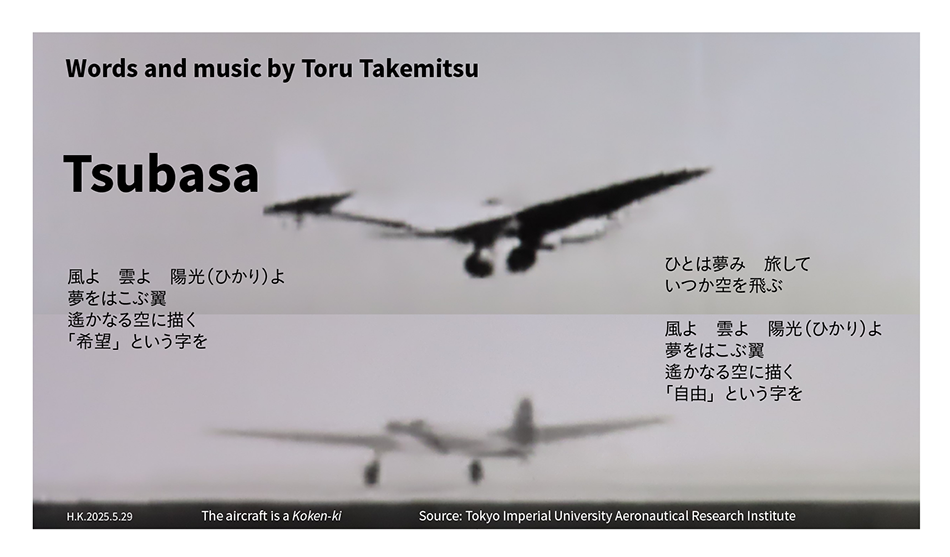 Toru Takemitsu (1930-1996) was a Japanese composer and one of the best known beyond our shores. While Takemitsu’s works included songs, few of these had lyrics he wrote himself. Accompanied by a beautiful melody, I feel that this song expresses freedom and conveys the dreams and desires of people embodied in science and technology or monozukuri.
Toru Takemitsu (1930-1996) was a Japanese composer and one of the best known beyond our shores. While Takemitsu’s works included songs, few of these had lyrics he wrote himself. Accompanied by a beautiful melody, I feel that this song expresses freedom and conveys the dreams and desires of people embodied in science and technology or monozukuri.
The song was composed for the play Wings written by Arthur Kopit about a woman who used to be a stunt pilot but has suffered a stroke and lost the ability to speak (1982).
Connections between Innovation, the Global Economy, and Conflict
In this final article of Part 3, I have considered where the essence of monozukuri is to be found.
2025 marks 80 years for Japan since the end of the war. While we tend to think that, in the early years of aviation, the leading-edge of industry always had a close relationship with conflict, it becomes apparent on closer investigation that this was not always the case.
In the latter stages of the Second World War, when not only science and technology, but also culture and the arts were being mobilized for propaganda, the Aeronautical Research Institute remained affiliated with the Ministry of Education right through to the end of the war. In that regard, it offers great inspiration and hope that, right to the end, there were still people who, rather than directing their research and development toward the machinery of war, instead contemplated human society a century hence and were devoted to civilian aviation, science and technology, and monozukuri. The first flights realizing Shunichi Bando’s dream of long-distance commercial air services to Palau began in 1940. This was the same year in which the Aeronautical Research Institute also got to work on developing the A-26 prototype to provide the range needed for civilian flights between Tokyo and New York, an accomplishment intended to mark 2600 years since the Accession of the Emperor Jinmu and to foster good will between Japan and America. It is of great sadness to me that history records these initiatives as all but coinciding with the surprise attack on Pearl Harbor, which took place under intense secrecy.
The Engineering Ethics and Education for Human Security and Well-being Project of the policy recommendation committee at the Engineering Academy of Japan (EAJ) has been running since 2023.
EAJ Report 2024-01 “Research Study into Engineering Ethics and Engineering Education for a Desirable Future” Final Report
https://www.eaj.or.jp/?page_id=18025
https://www.eaj.or.jp/?page_id=13818
A significant response was garnered by a session entitled “Why War?” at the 2024 and 2025 Koyasan Conferences run in close partnership by RCAST and the Kongobu-ji temple at Mount Koya.
https://www.brain.rcast.u-tokyo.ac.jp/koyasan/wp-content/uploads/2025/03/koyasan2024-report.pdf
https://www.brain.rcast.u-tokyo.ac.jp/koyasan/koyasan2025/セッション04/
https://www.rcast.u-tokyo.ac.jp/ja/news/ssr/20241101_01.html
In 2025, 80 years after the end of the war, the August 16 morning edition of the Asahi Shimbun newspaper carried two editorials side by side. One was entitled, “The Day the War Ended and the Prime Minister: Telling of a Vision of a Future as a Peaceful Nation” and the other was “Koyasan Asks: Why Do People Go to War?”
It is becoming more and more evident that future ethics and education will need to address “innovation, the global economy, and conflict.”
Column: Flying Boat in Japanese Tradition Potentially Vital for Quelling Forest Fires
Figure 14—Forest Fires Around Los Angeles, USA, and Untapped Potential of Flying Boats
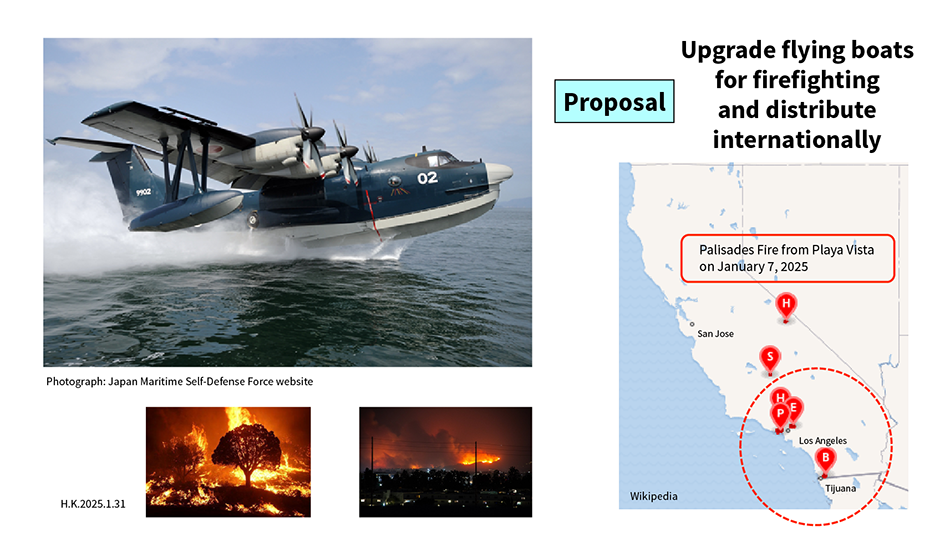 The California forest fires that burned continuously for about a month in the early New Year of 2025 were spread by strong winds, burning out the ocean-side Palisades neighborhood, and were not extinguished until the rains eventually came. As the use of large numbers of fire hydrants to fight the fire at the same time led to a loss of water flow, fire-fighting aircraft were called in to help. While the 747 Supertankers operated by Evergreen Aviation are among the world’s largest fire-fighting aircraft (being a remodeled version of Boeing’s jumbo jet able to carry 74 t of water at a time), their use has not always been practical due to constraints such as the need for flying low over mountainous terrain, long landing strips, and the time taken to load water. The aircraft came not only from the USA, but also Canada, which provided two Canadair CL-215 firefighting flying boats (including the Bombardier CL415) to assist with fighting the fire. These aircraft have been used in locations around the world, benefitting from their agility, being medium-sized twin-engine flying boats capable of taking on 6 t of water in 12 seconds in their fire-fighting configuration. The passenger version of the aircraft can carry 30 people.
The California forest fires that burned continuously for about a month in the early New Year of 2025 were spread by strong winds, burning out the ocean-side Palisades neighborhood, and were not extinguished until the rains eventually came. As the use of large numbers of fire hydrants to fight the fire at the same time led to a loss of water flow, fire-fighting aircraft were called in to help. While the 747 Supertankers operated by Evergreen Aviation are among the world’s largest fire-fighting aircraft (being a remodeled version of Boeing’s jumbo jet able to carry 74 t of water at a time), their use has not always been practical due to constraints such as the need for flying low over mountainous terrain, long landing strips, and the time taken to load water. The aircraft came not only from the USA, but also Canada, which provided two Canadair CL-215 firefighting flying boats (including the Bombardier CL415) to assist with fighting the fire. These aircraft have been used in locations around the world, benefitting from their agility, being medium-sized twin-engine flying boats capable of taking on 6 t of water in 12 seconds in their fire-fighting configuration. The passenger version of the aircraft can carry 30 people.
If the four-engine US-2 were to be redesigned as a fire-fighting flying boat and evacuation aircraft, it would be able to offer many times the capabilities of other flying boats in terms of capacity for taking on water and for carrying evacuees, not to mention its other features.
High-performance firefighting flying boats may prove to be vital when it comes to dealing with the future forest fires that are expected to become more frequent as the global climate warms.
Column: Rescue Flying Boats Land on Tokyo Bay after Great Kanto Earthquake
I wrote earlier about Shunichi Bando. It is also recorded that he immediately sent flying boats from Kansai via Shimizu Harbor in response to the Great Kanto Earthquake. Nippon Koku (no relation to today’s Japan Airlines despite having the same Japanese name) was established in April 1923 and it was in September of that year that the Great Kanto Earthquake struck. Of the five flying boats that had only just entered service on the new civilian flights that started in July (a result of development by a predecessor company), the new company’s managing director, Shunichi Bando, directed that two be immediately dispatched from Kansai to Tokyo Bay, traveling via Shimizu Harbor and carrying a specially arranged contingent of reporters. After flying over a burning Yokohama and Tokyo, the flying boats put down off Shinagawa and began relief efforts as soon as the reporters had alighted. Bando and his team arrived on another flying boat the day after the earthquake, landing in the water off Shinagawa in Tokyo Bay. When the pilot was cautioned about large amounts of driftwood in the vicinity, it turned out that this was actually the bodies of victims. For 18 days, they assisted with the carrying of airmail, carrying a total of 60,000 items from Tokyo Bay to Shimizu Harbor (where there was a connection to the railway). How Namihei Odaira of Hitachi also put considerations of profit aside and made every effort to restore Tokyo’s electricity and railways is recounted elsewhere in this series of articles.
That flying boats are especially useful during disasters has already been demonstrated by the Great Kanto Earthquake.



